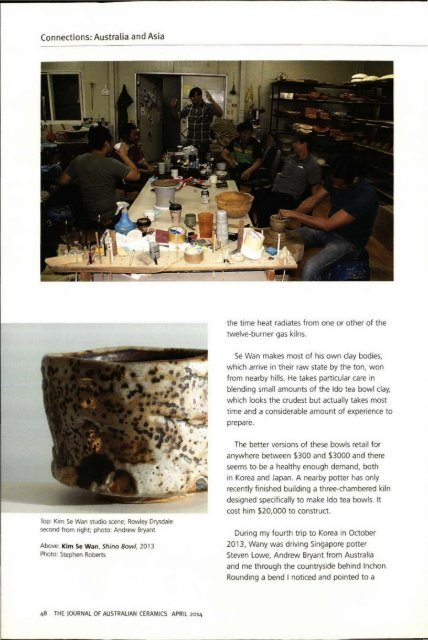The Journal of Australian Ceramics Vol 53 No 1 April 2014
You also want an ePaper? Increase the reach of your titles
YUMPU automatically turns print PDFs into web optimized ePapers that Google loves.
Con nections: Australia and Asia<br />
the time heat radiates from one or other <strong>of</strong> the<br />
twelve-burner gas kilns.<br />
Se Wan makes most <strong>of</strong> his own clay bodies,<br />
which arrive in their raw state by the ton, won<br />
from nearby hills. He takes particular care in<br />
blending small amounts <strong>of</strong> the Ido tea bowl clay,<br />
which looks the crudest but actually takes most<br />
time and a considerable amount <strong>of</strong> experience to<br />
prepare.<br />
Top: Kim Se Wan studio scene; Rowley Orysdale<br />
second from right; photo: Andrew Bryant<br />
Above: Kim Se Wan, Shino Bowl, 2013<br />
Photo: Stephen Roberts<br />
<strong>The</strong> better versions <strong>of</strong> these bowls retail for<br />
anywhere between $300 and $3000 and there<br />
seems to be a healthy enough demand, both<br />
in Korea and Japan. A nearby potter has only<br />
recently finished building a three-chambered kiln<br />
designed specifically to make Ido tea bowls. It<br />
cost him $20,000 to construct.<br />
During my fourth trip to Korea in October<br />
2013, Wany was driving Singapore potter<br />
Steven Lowe, Andrew Bryant from Australia<br />
and me through the countryside behind Inchon.<br />
Rounding a bend I noticed and pointed to a<br />
48 THE JOURNAL OF AUSTRALIAN CERAMICS APRIL <strong>2014</strong>

















